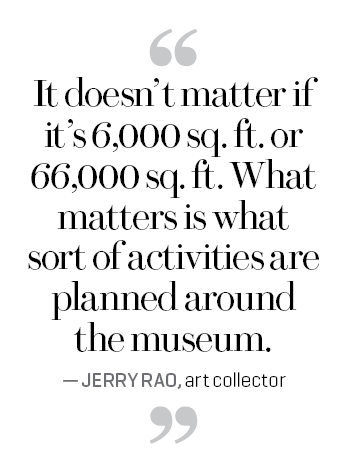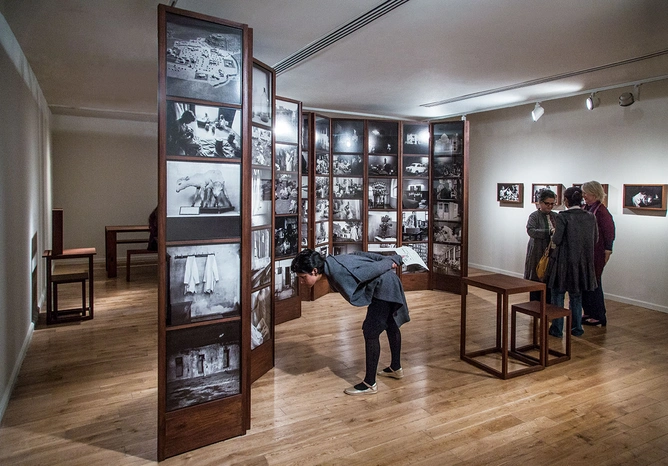The years preceding his death in 2007 saw Heinz Berggruen either give away or sell for symbolic amounts the works of masters such as Picasso, Matisse, and Klee to museums in Berlin, the city of his birth which he had fled during Nazi rule. “Berlin should shine,” the noted collector said of his decision, which was at once a gesture of reconciliation and a step towards restoring to the German people the artworks to which they had lost access during Nazi rule. The collector’s son, Nicolas Berggruen, who sits on the board of trustees of the Los Angeles County Museum and the Berggruen Museum, and Sotheby’s international advisory board, says art is acquired by individuals, but it also belongs to a culture. “It is inspiring because it survives down the generations and can be shown and re-shown.”
Going by the rise in the number of private museums over the past decade, India’s business dynasties and serious collectors are thinking on the same lines. But sharing a collection takes more than just the ability to build one. It calls upon an instinct to create a cultural space that will nurture art communities.
Over the past decade, collections confined to residences and summer homes have started to make their way into private museums. The law stipulating that companies spend 2% of their three-year annual average profit on philanthropic activities is expected to offer further impetus to this trend.
Last November, the Piramal Museum of Art opened its doors to the public. Piramal group chairman Ajay Piramal says his aim is “to fast-track his hobby into a platform to share art with people”. Piramal started collecting when his business advisor Nitin Nohria, dean of Harvard Business School, suggested it as a way to enhance his asset base while enjoying and sharing something with the community. Spread across the 6,000 sq. ft. ground floor atrium of Piramal Tower in Mumbai’s Lower Parel, the museum will showcase works from Piramal’s own collection as well as those of other collectors. Admission is free and “anyone can walk in”, says Ashvin Rajagopalan, the museum’s director.
Then there’s the Dashrath Patel Museum, named after the late designer and artist. Pinakin Patel, founder of the Mumbai-based interior design and architecture firm Pinakin Design, wanted to purchase Dashrath’s works. But the artist was so reluctant to sell his works that he had earlier refused to even get them catalogued. Pinakin believed Dashrath’s oeuvre deserved a bigger audience, which sparked the idea of a museum. Curated by Dashrath’s friend and art critic Sadanand Menon, the museum opened in 2009 in Alibag. Similarly, hotelier Anupam Poddar and his mother Lekha Poddar turned over their personal collections to a museum set up in 2008 in Gurgaon under their non-profit, the Devi Art Foundation.

The Kiran Nadar Museum of Art, opened in 2011, is a 18,000 sq. ft. space at a premium South Delhi mall, featuring some of the leading names in 20th-century Indian art. Nadar, an art collector and wife of HCL Technologies founder Shiv Nadar, owns some 3,200 works through the Shiv Nadar Foundation. She is in the process of selecting a parcel of land in Delhi to set up another museum across 150,000 sq. ft. “It’s important to create an iconic building that will stand for the sort of heritage that a museum reflects,” she says.
Excluding the cost of the art and the building, setting up a museum can cost between Rs 1.5 crore and Rs 5 crore. This includes expenditure on lighting, licences, legal fees, and the salaries of curators and managers. For most private museums, the founders put in their own money, or tap sources such as foundations or philanthropic grants.
In Nicolas Berggruen’s view, museums have evolved differently the world over. In Europe, royal families built private collections, which later became part of state’s collections, displayed for the public and the larger benefit of the arts. In the U.S., large business families such as the Gettys and the Morgans took the lead. Berggruen believes that private museums in India too can achieve global standards.
Unlike government-funded museums, the private ventures can get off the ground faster and exercise better control on the quality of exhibits. Seeking support from corporate houses can be a way forward for such museums. In fact, that’s the path that some of the earliest ventures in modern India had taken. As early as 1949, The Calico Museum of Textiles opened in Ahmedabad with support from the industrial family of the Sarabhais. In Kolkata, industrialist Basant Kumar Birla and his wife Sarla, both serious art collectors, established the Birla Academy of Art & Culture in 1967.
Although Indian museums can boast world-class collections, they have lagged behind in management and maintenance. At Hyderabad’s Salar Jung Museum, which houses a large private collection of carpets, ivory, porcelain and other antiques, the shoddy display is an example of how not to run a museum. Lighting, temperature, and humidity are not regulated, vintage oriental rugs lie unprotected, prone to bugs and fungus, and the artefacts are not properly described.
Rakhi Sarkar, director of Kolkata’s CIMA Art Gallery, says the state-run model hasn’t worked, leaving much to be done in cataloguing, conservation, restoration, and archiving. The Kolkata Museum of Modern Art, or KMOMA, of which Sarkar is a driving force, is a partnership between the central and the state governments and the private sector. The Rs 400 crore project is expected to be completed in three years.
Sabyasachi Mukherjee, director-general of Mumbai’s Chhatrapati Shivaji Maharaj Vastu Sangrahalaya (CSMVS), says that the aim to serve the public is a must for any museum to stay active and popular. While its rationale should be educational, not commercial, it should have the financial nimbleness of an autonomous entity.
CSMVS itself has traversed a similar arc. In 1905, a group of prominent citizens resolved to commemorate the visit of the Prince of Wales by setting up a museum named after him. Since its opening in 1922, bequests such as the Tata collections in 1922 and 1993, the Akbar Hydari collection in 1934, and the Karl and Meherbai Khandalavala collection in 1955 added to the museum’s stature. It functions as an independent body, with revenue coming from more than a million tickets it sells in a year. “Our collections aren’t controlled by any person or a company. They are for the public, who we see as the actual owners,” says Mukherjee.

To his point, the pressing question is: Anyone with the means can start a museum, but how can it stand the test of time? Rajagopalan says the Piramal museum would be well served for a few years if it can get commitments to display the collections of just 10 of the top billionaires in Mumbai. But maintaining a high quality of exhibits and making sure a wide range of talent is showcased is critical; having one without the other is not an option. Javed Abdulla, who started Sotheby’s Indian art department in the 1990s and is its consultant, says the focus should be on a select group of artists and on a small number of genres rather than trying to serve something of everything.
Cutting corners on basics such as lighting, layout, and architecture, and compromising on the calibre of curators are bad practices. Abdulla’s advice: “Pay top dollar and get immortality in return.” Which is why Sarkar emphasises the need to have a strong financial base—an endowment or a corpus—right from the get go.
At first glance, you could argue that for a museum, Piramal’s venture is erring on the side of modesty, given just 25 or 30 paintings can be shown at a time. But as former Citibank boss and art collector Jerry Rao says, “It doesn’t matter if it’s 6,000 sq. ft. or 66,000 sq. ft. What matters is what sort of activities are planned around the museum.”
Sarkar too believes in the power of programmes in determining a museum’s success. “A museum can’t be run like a warehouse,” she says, ergo just any home with lots of art can’t pose as a museum. “A museum has to be more than a venue to display art. It must become a place where artists, collectors, curators, and students come together for activities such as talks and workshops.”
At the end of the day, says Rajagopalan, a private museum is a reflection of the promoter’s taste. Piramal, for one, decides extremely quickly. “Once he is sure, nothing holds him back. If there’s something he dislikes, that’s it. He wouldn’t buy even if you slashed the price by 50%.” He recounts his first meeting with Piramal in 2009, which started off with a call from someone representing “a private, serious buyer”, asking him to look for a particular M.F. Husain painting. He then received step-by-step instructions on bringing the painting to Mumbai. Until he landed, he didn’t know where in the city he was supposed to go. He ended up face-to-face with Piramal, who looked at the painting for a few seconds, after which Rajagopalan was handed an envelope with a cheque in it, no questions asked.
According to Mukherjee of CSMVS, with the government running 95% of India’s museums, there’s a lot of scope for private initiatives. For a nation steeped in art heritage and with a growing list of high-net-worth individuals, private museums have a chance to make sure that India shines.
Note: Rakhi Sarkar is from the family that owns Business Media Pvt. Ltd., the publisher of Fortune India.










Leave a Comment
Your email address will not be published. Required field are marked*